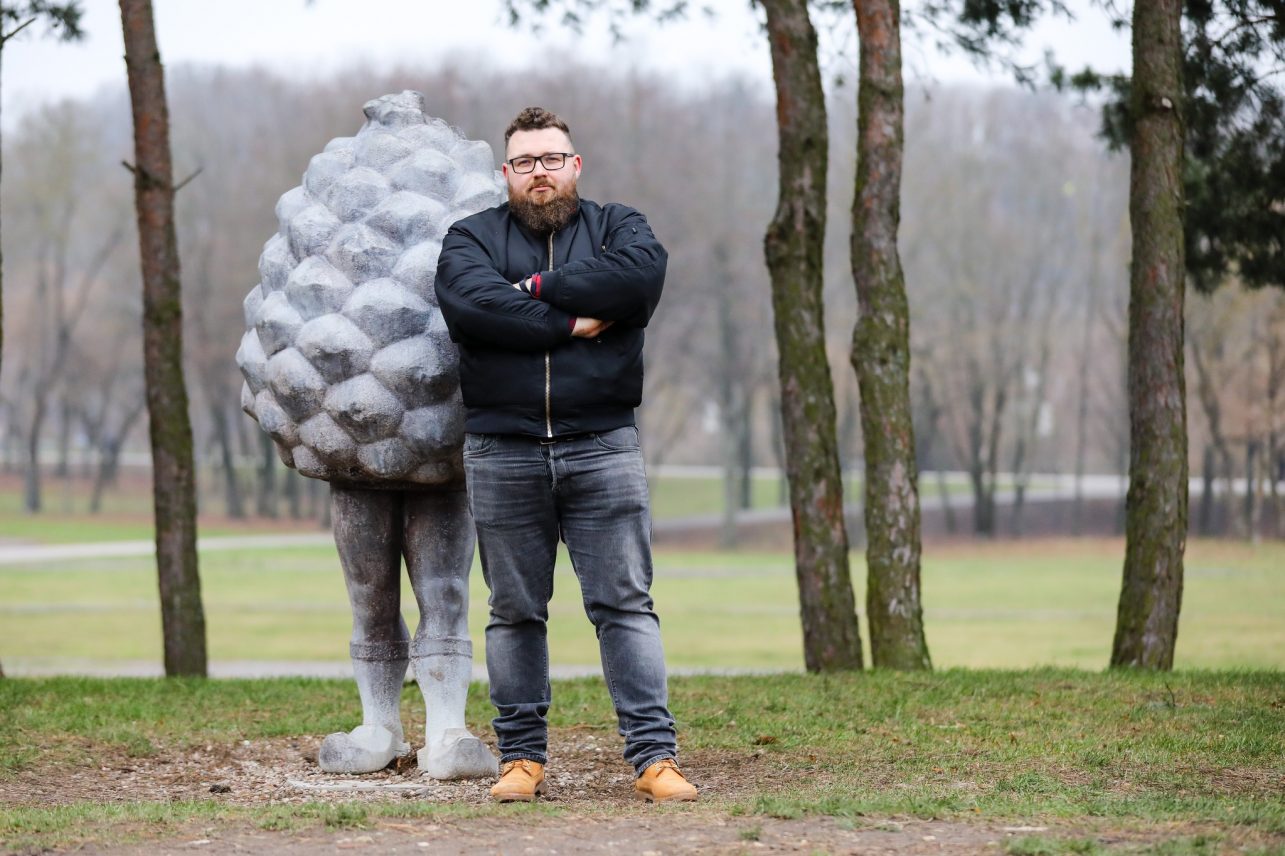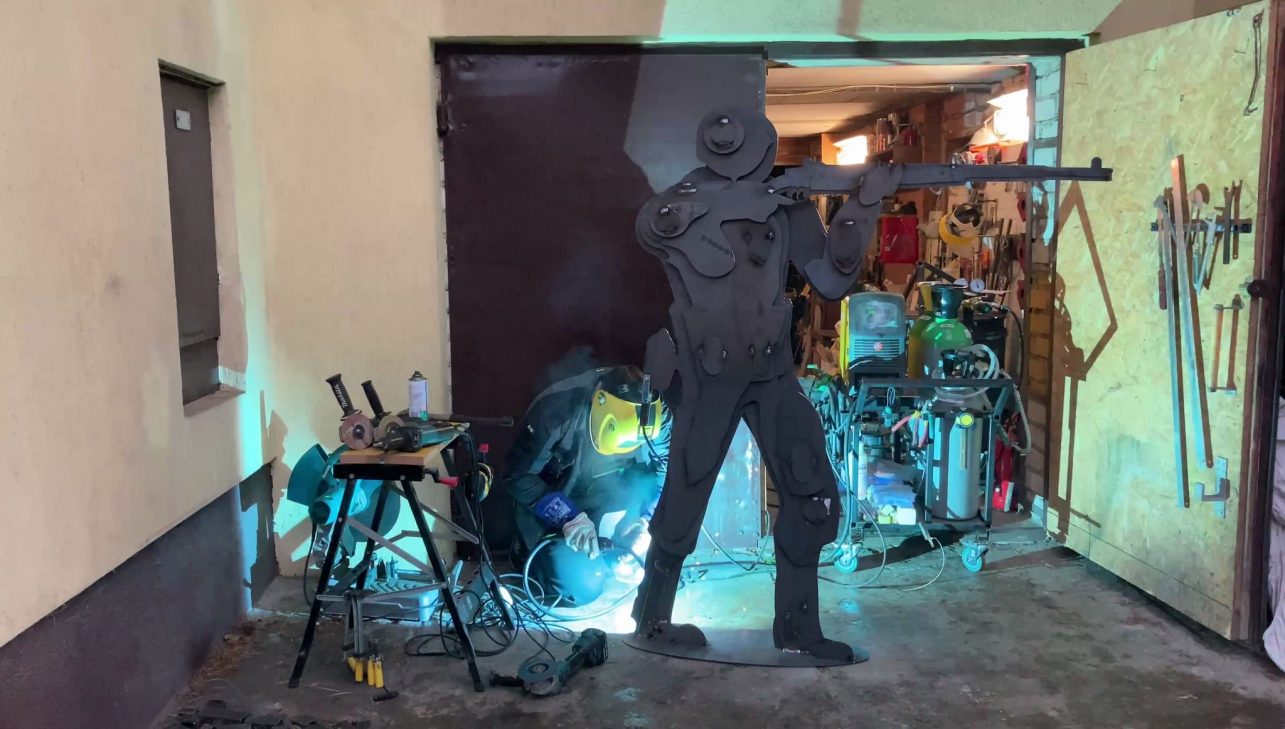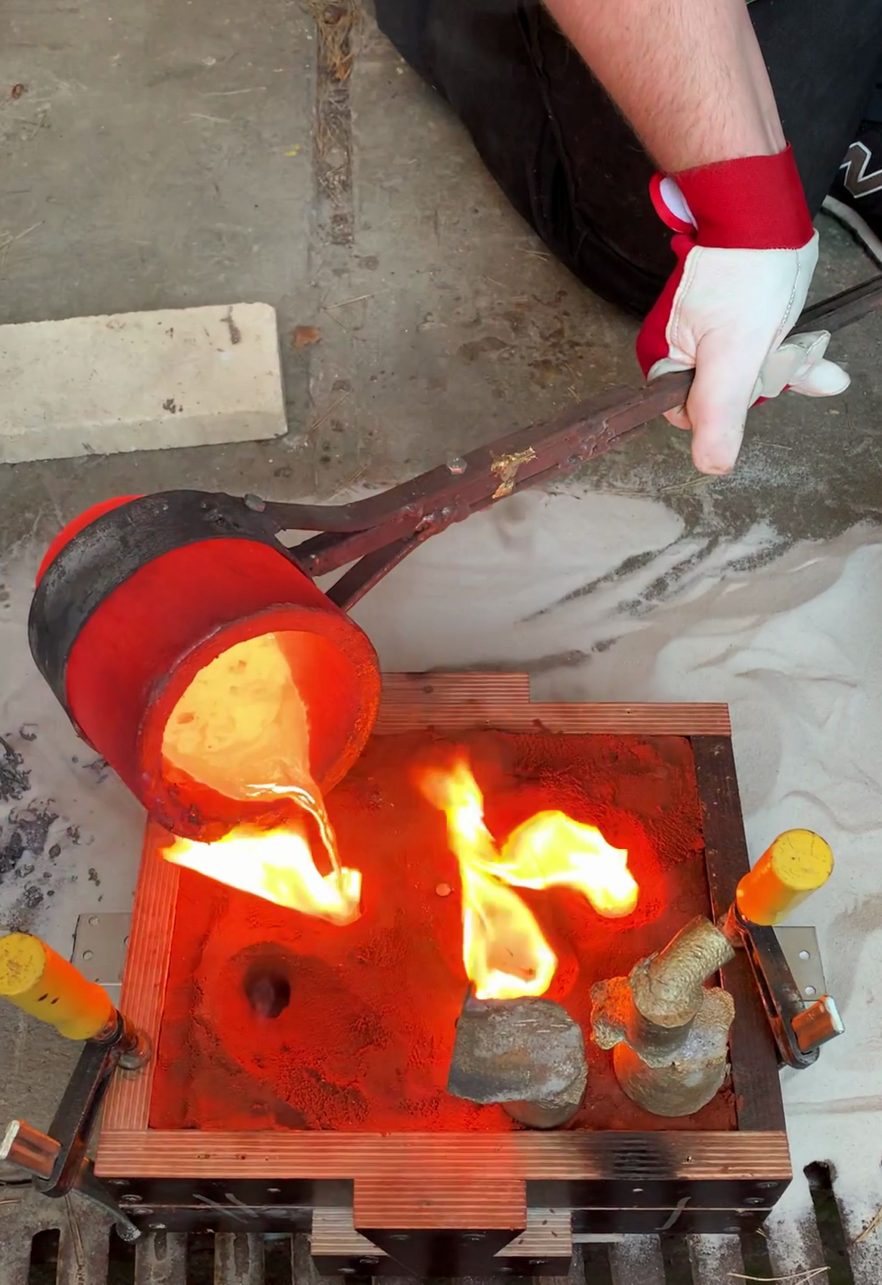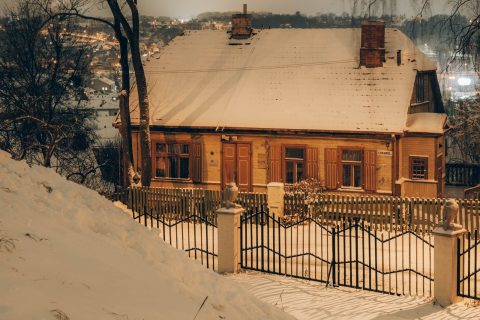“Art is a way of thinking and an opportunity to articulate abstract ideas into personal experiences. And sculpture, in my understanding, blurs the line between what “is” and what it “means,” says Lukas Šiupinskas, who is the head of the council of the Kaunas branch of the Lithuanian Artists’ Association, a lecturer at the Kaunas faculty of the Vilnius Academy of Arts and a sculptor. The artist, who was born and raised in Kaunas and who is currently doing most of his work in his hometown, is very happy to be able to decorate the city with his work. Some of the latest sculptures of Lukas appeared at the Fourth Fort of the Kaunas Fortress just a few weeks ago. We spoke to him about the processes of creating them and the entire prehistory of this trade.

Lukas, what environment did you grow up in and when did your artistic journey begin?
I would say that my artistic journey began in my childhood. As far as I remember, my family always valued art and creative work. My mother worked at the Kaunas State Musical Theater, and my father, even though he wasn’t an artist, had many Kaunas bohemians as his friends: poets, painters, and sculptors who always invited my parents to various shows and exhibition openings. am very happy about that, because although I was never deliberately pushed in the direction of art, I always felt strong support from my loved ones.
I don’t remember the specific moment when I realized that the activity I do now, is mine. Sometimes it seems that from a very early age I felt that art was something close to my heart. It may sound silly, but to this day I remember one funny situation when I gave my unmarried kindergarten teacher a drawing of a muscular man that I made myself. I felt really sorry for that lonely woman and felt the responsibility to draw her a man. Sometimes I think that that realization that I am an artist, came exactly at that age.
How did you first touch upon sculpting?
I first touched upon sculptures when I joined the art academy and started learning this craft. Although I had not encountered all of this before starting my studies, I received my first order for a sculpture on the first day of September, just as I became a university student. It so happened that a colleague’s relatives were looking for a sculptor and she decided to give them my number. The task was to make a 3,5-meter mould of the Žalgiris Euroleague cup in one month and a half. I decided to ask for help from my older friend Donatas who was a 3rd-year student of sculpture. To be frank, I still don’t understand how we managed to implement this order. The sculpture was placed in the middle of the hall and was unveiled during the competition, and the next day it appeared on the first page of the Kauno Diena newspaper. Pretty incredible when you think about it. Together with my colleague, we received 750 litas for this work – for that amount we were able to survive until the end of the semester and even get more materials to continue working. This experience helped me realize that even the biggest and most intimidating work can be accomplished if you put a lot of effort and assemble a good team.
Why sculpture?
Sculptures came into my life very unexpectedly. From an early age, I realized I was going to get into the arts, although for a long time I couldn’t decide on a specific field. Of course, there were other plans – I thought of becoming an animator and drawing cartoons, but there was no admission of new students that year. Several acquaintances suggested I check out sculpture, so since I wanted to create but didn’t know in what form, I decided to try out sculpture studies. I was lucky because as soon as I started studying, I realized that I was on the right track. True, I still love animation and the creation of animated characters, but I only do that to the extent required by sculpture projects.
Your pseudonym. Why kaukas (goblin)?
This name has followed me since my school days. At that time, I had invented and drawn many sketches and made graphic works of the Lithuanian mythological creature kaukas. After a while, when I became interested in sculpture, I recreated this character in three-dimensional works. In Lithuanian mythology, kaukas is the good spirit of the house which brings a wide variety of things to a person’s house, if he is deserving. I often work together with my other half, glass artist Gintarė Stašaitytė. We often create works for various interiors, so when in 2017 we were setting up our company, we decided that this would be our name. A good spirit that brings nice things to people’s homes. We couldn’t come up with a better symbol for our work. Customers often call and ask, “Good day, am I speaking to kaukas?” I find it kind of charming and fun.
What does your creative process look like?
The creative process is ongoing. Every day I sketch and write down all sorts of ideas that come to mind. If I don’t have a specific topic or order in mind, I do it for personal joy and professional interest. I spend at least a couple of hours every day: modelling, moulding, or working with a mould. When you do all this constantly, in the long run, it works like a sport – creative muscles and observation begin to develop. A little later, when a specific topic, order, or competition emerges, I already have many impressions and ideas or sketches that I can use as a starting point. After all, it so happens that you remember the beginning of a thought, make a sketch, and only after a few years a space or a client’s house appears, which leads to the fulfilment of that idea. Sculptures require patience.
Who has impacted you the most in your work?
Actually, many different artists from a wide variety of fields. I couldn’t choose one, so I will try to give a few names that got stuck in my subconscious: writer Umberto Eco, director Tim Burton, sculptor Jeff Koons, or painter Hieronymus Bosch. I am mostly influenced by those artists, whose production I like to consume myself.


What makes your works stand out?
I would say that I have an original style. I am fond of grotesque in art, which I try to combine in my work, something very tempting and visual, but at the same time very scary and unfamiliar.
Are you trying to broadcast a message to the public with your works?
My works have never broadcast any one particular thought. Usually, different themes prevail, and different locations are chosen, so this would simply be impossible. Although, of course, like every other artist, I always try to create a personal, emotional, sensory connection with my work and provide a cathartic experience. The best compliment I’ve heard was from an elderly woman, who was exercising in Santakos Park next to my sculpture Human Pinecone. She said, “I don’t fully understand what it is, but I really like it.” For me, as a sculptor, this is the best evaluation. A person doesn’t know what it is, or what it’s for, but intuitively shows interest and pays attention, it is much more important for me than spreading a specific message.
Describe your work in three words. Why these associations?
Mythology, Déjà vu, and archetype. I like to give the impression that there is something familiar in the artwork but at the same time incomprehensible and new.
Do you remember the first sculpture or other artwork that you bought with your own money?
Although now our home with Gintarė contains many works, I remember very well the first graphic artwork I bought with my own money – Karolis Strautniekas’ Pool. When I bought it, we didn’t have a wall in the house on which to hang this work, so we kept it in the closet for two years. Only when we built our own home did we finally hung it on the wall.
Have you ever imagined yourself having a different profession?
As I already mentioned, in my youth, I often imagined myself as an animator. I think it could be my second profession if, for some reason, I could no longer create sculptures. If we were to talk hypothetically, then I would probably choose gastronomy. I really enjoy cooking and I see a lot of parallels between the culinary and art world.
What local galleries, museums, or sculptures inspire you?
Kaunas Photography Gallery is one of the most professional galleries in Kaunas. As for the sculptures that inspire me, I would say Robertas Antinis Jr’s monument Field of Sacrifice dedicated to Romas Kalanta and Tadas Vosylius’ Net. These works remind me that there is always the opportunity to do things anew, intuitively, and differently than everyone else.
Is there still a lack of freedom in creation?
I don’t think so. We live in free time, in a free country, and in a free economy. In fact, I don’t even really understand what creative restrictions are; no one is standing next to an artist with a rifle telling him to sculpt, for example, Lenin. Yes, there are obstacles when you want to implement your works in a public place, but the city disagrees. However, I always tend to think that solution can be found – an artwork can find a private client, gallery, or museum. The biggest problem, in my opinion, is that many artists surround themselves with complexes and fears and are no longer able to create freely in their own workshops.
Perhaps you can name three sculptors who should be on the readers’ watch list?
If we talk about Kaunas, then Tadas Vosylius, in Lithuania Martynas Gauba and in the world, of course, KAWS. And if the readers have time, they can remember me as well.
Currently, there are three people on my list of favourite sculptors: Jeff Koons, Damien Hirst, and Antony Gormley. All these artists found the perfect balance between visuality and conceptuality, modernity, and durability. Sometimes people say that these are the opposite poles, but I disagree with that.
Are you currently working on any new sculpture that will soon decorate Kaunas?
In the second half of December, I finished installing sculptures for the approaches of the Fourth Fort of the Kaunas Fortress. These are three sculptures depicting enlarged soldiers that draw the visitors of the fort into an artistic scenography created by the artworks and militaristic environment. In fact, I am very happy to be able to finish the year working.




